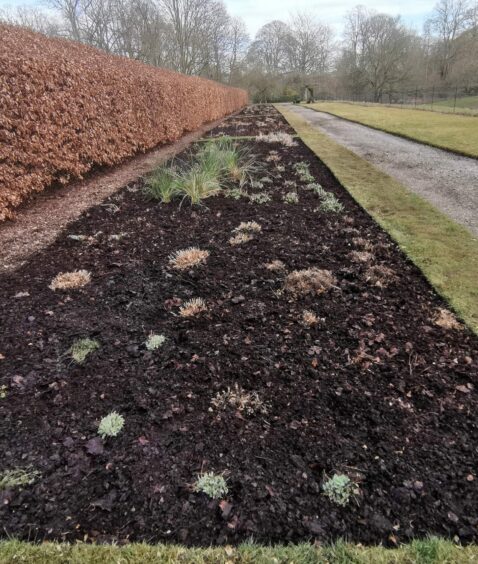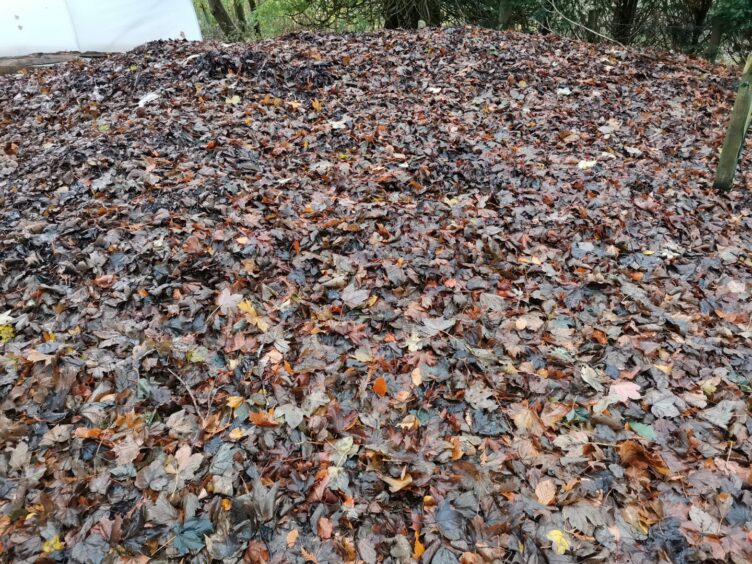Effortlessly performing their aerial dance – swirling and tumbling gracefully down. Streaks of magenta, auburn and gold rain from the sky.
Relentlessly gathering indiscriminately across paths and lawns.
The leaves of autumn finish their time on the branch. Ready to begin their cycle of feeding the ground once again.
Hard work
It’s a task, I won’t lie. Gathering leaves in autumn IS a task.
At Duthie Park when I was still a young gardener with a head full of hair, we’d spend three months doing it.
Out with the noisy blowers, blowing it off the grass on to the hard tarmac paths into strips.
The tractor and trailer would drive over the strips while some hard-working gardeners would fling them up into the cart with snow shovels.
It’s much the same all over. Gather the leaves by rake or blower into piles and get rid of them.
Where you get rid of them though is another matter.
Ideal for mulch
The thing with all those leaves is that they make pure garden gold.
If you collect your leaves and put them in a pile like you would with compost, then you’ll get eventually get a broken-down product called leafmould.
After a year or so breaking down, then it’ll be ready to use as mulch. Ideal mulch for any garden bed or border.
It provides an initial covering on the soil to suppress weeds, retain warmth and moisture then, in time, it’ll naturally incorporate into the very soil it rests on thanks to our beautiful friends that lie within it.
I am of course talking about the fauna found in the soil biosphere. Worms, beetles, etc all breaking down the detritus and playing their part in the soil make-up.
Soil is made of distinct horizons
- At the bottom deepest layer called the R horizon, is bedrock.
- Above this is the C horizon, the parent rock.
- Above this B horizon, the subsoil.
- Above this E horizon, the eluviation layer of leached minerals and organic matter.
- Above this A horizon, the topsoil.
- The very top layer is the O horizon, the humus.
The humus is made up of organic matter on the surface breaking down.
Leafmould is a prime example of this humus.
Most farmland in Scotland was once forests that had incorporated thousands of years of humus from leaf matter to create fertile topsoil and well-draining subsoil.
Ideal for potting mixes
Leafmould is also a grand product to use in potting mixes. A fine vintage can be made by allowing it to break down very well for two years plus.
This can become as fine in the hand as compost.
To ensure this, we shake it through a garden sieve called a riddle. It allows the finely broken-down leaves through and removes detritus like sticks and stones.
It can be mixed directly with sharp sand in equal parts to make mixes for seed sowing. It’s a fine structured but low nutrient medium ideal for getting those seeds to germinate.
Add equal parts loam and you’ve got yourself a great general potting mix for pricking out those seedlings in to once they’re ready.
Bag them up
You don’t have to have fancy bays to make your own leafmould. At work we have large bays because we have a heck of lot of leaves to pick up.
We equally have a heck of a lot of beds to mulch and plants to grow. At home though you might have lots of leaves or maybe just a dusting.
Regardless, you can use a strong rubble sack or even old builder’s ton sacks to store your leaves.
Just make sure they have a hole or two in the bottom to let the rainwater out or you’ll end up a putrid stinking mess!
The rubble sacks or thick bin liners should be filled with damp leaves (or if filled with dry leaves then given a slight moisten) then closed and a small hole or two popped in the bag to let the air in while the moisture helps the break down.
The breakdown
The breakdown happens because of slow-acting fungi working in cooler conditions than the faster and hotter conditions found in compost heaps where bacteria are breaking it down.
To speed up the leafmould process you can finely shred your piles by running over them with your lawnmower first which will almost double the speed at which they break down.
Especially so for the leaves higher in lignin content like beech, birch and oak.
Higher lignin levels mean slower breakdown of the leaf.
Leaves with lower lignin levels include cherry, lime (linden) and maple. These will break down more quickly.
Why not try it out for yourself? You’ll be amazed by the results however you use it!
Take care and happy gardening.






Conversation